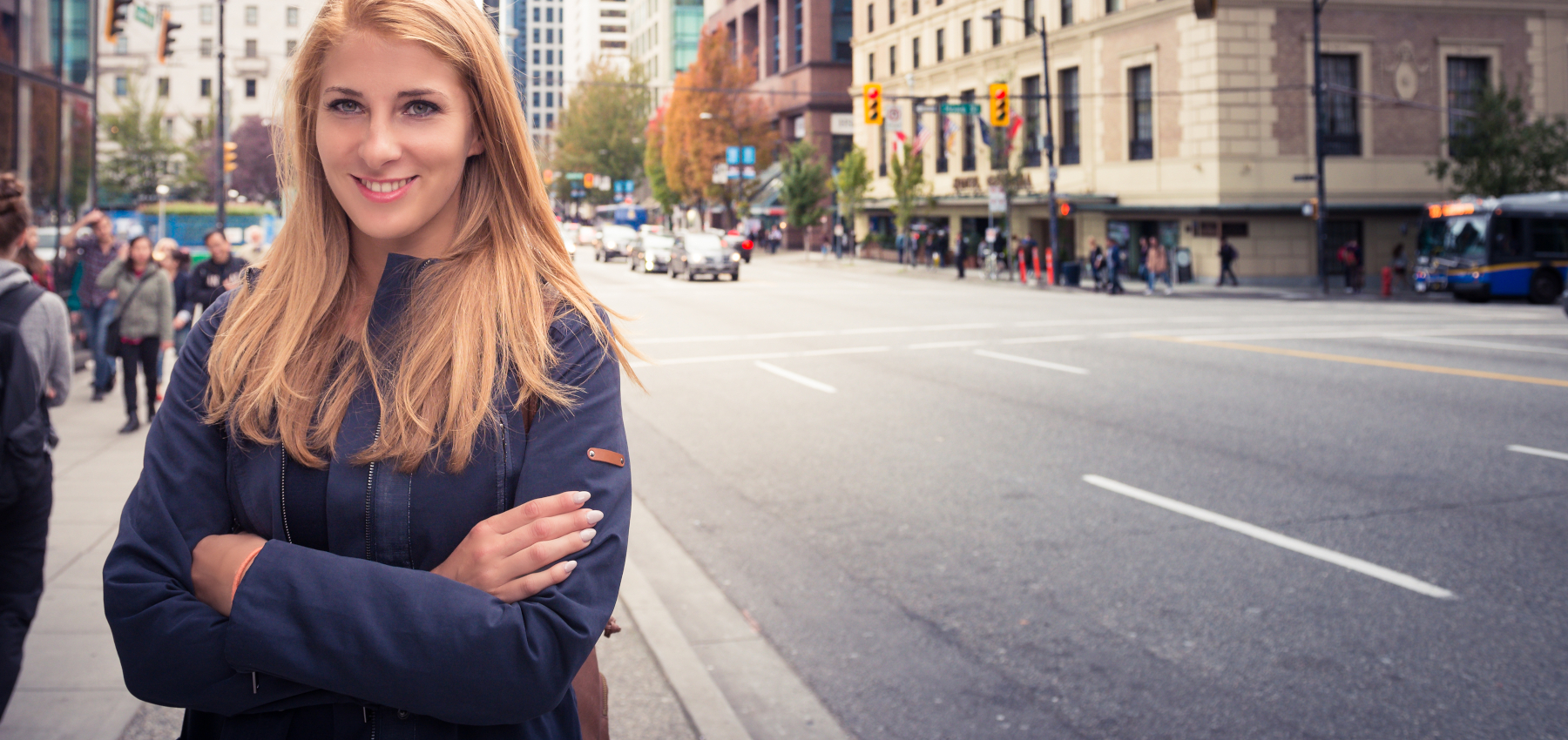Once described as “Manhattan with mountains,” Vancouver, located in British Columbia, is a popular choice for newcomers to Canada. With some of the mildest weather in Canada, postcard-perfect views, and vibrant downtown core, it’s no wonder. Here is what you need to know if you’re planning to settle in Vancouver.
Vancouver
Vancouver is the largest city in western Canada. It was originally named Gastown after beginning as a settlement in 1867 around a makeshift tavern. In Vancouver, nature never seems far off. Beaches, mountains, and forest trails are right at your doorstep. Greater Vancouver had a population of almost 2.5 million as of 2016 and the fifth-most densely populated city in North America. It’s one of Canada’s most ethnically diverse communities and ranks as one of the most liveable cities in the world.

Downtown Vancouver
Key highlights
Vancouver is a coastal seaport city with a densely populated core and sprawling suburbs to the south and east. Here are just some of the most neighbourhoods to explore:
Gastown
This is the downtown neighbourhood where Vancouver began. Named in honour of John “Gassy Jack” Deighton in 1867, it started as a single tavern and retained its charm. Gastown lies along the north of the downtown and, with a mix of old and new, is known for its Victorian architecture, restaurant scene, and shopping. While you’re here, visit the working steam clock – one of the few in the world.
Commercial Drive
Situated in East Vancouver, or “East Van,” this neighbourhood is rich in culture and diversity. It’s home to Vancouver’s Little Italy and, as you’d expect, offers espresso bars, gelato counters and authentic Italian restaurants. The area is also known for its vibrant music scene and bars. Nearby John Hendry Park hosts a farmers’ market from May to September and is known locally as Trout Lake. Commercial Drive also contains a mix of residential Queen Anne style houses.
Kitsilano
The beachside community of Kitsilano (“Kits”) was a well-known hippy hangout in the 1960s. Situated West of Vancouver, it’s popular with young families and students. Some of the city’s best attractions are here, including the Museum of Vancouver and the Vancouver Maritime Museum. Kitsilano has a salt-water pool by the ocean, a local farmers’ market at the Kits Community Centre, and plenty of yoga studios. Given its roots, it’s not surprising Kits also has the city’s oldest vegetarian restaurant, The Naam.
Yaletown
At one time, this neighbourhood was the terminus for the Canadian Pacific Railway and filled with red brick warehouses. Today, Yaletown has been transformed into one of Vancouver’s hippest areas, with a huge seawall that connects George Wainborn Park and David Lam Park. It’s a popular spot for jogging, cycling or rollerblading. Yaletown’s warehouses have been converted into trendy lofts. And the area is filled with chic restaurants, patios, and local breweries.
Granville Island
Part of the fun of visiting Granville Island is getting there. Take the tugboat ferry across False Creek to Granville Island’s public market. The market is a great place for a seafood lunch; afterwards, watch a street performer, see an art exhibition from students at the Emily Carr University of Art and Design, or stop for a beer at the Granville Island Brewing Co.
West End
The West End is the gateway to Stanley Park. This part of Vancouver is also where you’ll find Vancouver’s LGBTQ+ community, situated around Davie Village and the heart of the Vancouver Pride Festival. The West End is also the location of English Bay, a large stretch of beach. Here you can try stand-up paddleboarding or watch the sunset.
To browse homes for sale in these and other Vancouver neighbourhoods, visit Houseful.
Key considerations for moving to a Vancouver neighbourhood
Access to public transit
Vancouver offers residents a convenient and accessible public transit system. TransLink connects Metro Vancouver and is responsible for running the SkyTrain, SeaBus, and a network of buses. The SkyTrain is a light rapid transit system that connects Vancouver’s downtown with the suburbs. There are three different SkyTrain lines, including service to Vancouver International Airport (YVR). The SeaBus is a ferry service that connects the downtown Waterfront Station to Lonsdale Quay on Vancouver’s North Shore. There is an extensive range of bus routes covering the city, and service runs from 5 a.m. to 1 a.m. on the most popular routes. A bus ride is a standard fare, regardless of the distance you travel. However, the SkyTrain and SeaBus are broken up into three fare zones. Buses accept cash fares, but for the SkyTrain and SeaBus, you’ll need to purchase a single Compass Ticket at a vending machine or a refillable Compass Card for multiple trips.
Cycling is a fun and scenic way to travel around Vancouver. A cycling map of the city is available, and with bike racks on buses, the SkyTrain and SeaBus, it’s easier to get around. However, be aware that bike theft is a common problem in Vancouver. Public bike share is also available with Mobi, and passes are available for 12 hours, 30 days, or 365 days.
Depending on where you live in Vancouver, it’s easy to get around without a car. For instance, downtown Vancouver is walkable and has access to public transit. Car share companies like Evo and Modo make living in this city without owning a car even easier.
Tip: Avoid waiting for long times at bus stops or subway stations when it’s cold or dark outside. Download a free transit app for Vancouver like Rocketman and use it to find out when the next bus or train is arriving. Rocketman allows you to track your bus along its route, save favourite stops, and get transit delay alerts in real-time. Learn more about using public transportation in Vancouver.
Recreation and shopping
With more than 190 parks, beaches, and a stunning backdrop of the Rocky Mountains, many Vancouverites take their relaxation seriously. With over 27 km of walking trails, Stanley Park city’s largest urban park. Here you’ll find people hiking, jogging, cycling, or rollerblading. As well as its famous seawall, this urban oasis is also home to the Vancouver Aquarium, First Nations Totem Poles, and three beautiful gardens. Dr. Sun Yat-Sen Classical Chinese Garden in the heart of Chinatown hosts exhibitions and classes. Further out, Grouse Mountain in North Vancouver is one of the city’s most popular destinations, with skiing, snowshoeing, and ziplining.
Kitsilano Beach is popular with locals and has a heated outdoor pool, while English Bay is popular with rollerbladers or families picnicking. It’s also an ideal location to watch the Celebration of Light fireworks display in the summer.
The city is also home to major festivals, including the Vancouver Cherry Blossom Festival each spring, Bard on the Beach, International Jazz Festival, Dragon Boat Festival, and the PuSh International Performing Arts Festival.
When it comes to shopping, Vancouver offers a mix of large department stores, boutiques, and one-of-a-kind outlets. Centrally located, Robson Street is the city’s most popular shopping area and contains a wide range of brand-name stores. The Pacific Centre in downtown Vancouver is an indoor mall that runs for several blocks and contains over 100 stores, including Holt Renfrew and Nordstrom. Granville Island Public Market is a popular place to pick up artisan foods, jewellery, and unique crafts, while South Granville has a mix of high-end boutiques and art galleries.
Schools
The Vancouver School Board (VSB) operates a multicultural school district with around 55,000 students attending 89 elementary and 18 secondary schools. Vancouver also has some excellent private schools, including York House School, West Point Grey Academy and Collingwood School.
For post-secondary education, the University of British Columbia (UBC) has a reputation for world-class educators and researchers and was recently ranked among the top 20 public universities in the world. Consistently ranked as one of Canada’s top universities, Simon Fraser University has a campus in Vancouver. The Emily Carr University of Art + Design (ECU) specializes in education and research in the creative sector. Vancouver Community College offers apprentice training, culinary and business accreditation.
Average rent
The average rent in Vancouver for a studio apartment is $1,650 CAD, a one-bedroom apartment is $1,925 CAD and a two-bedroom apartment is $2,600 CAD, according to Zumper. Read more about top tips for first-time renters in Vancouver.
Crime rate
The Crime Severity Index for Vancouver is 108, higher than the Canadian average of 75.01. However, West Vancouver is 63, and the City of North Vancouver is 71.




